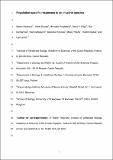Files in this item
Population-specific responses to an invasive species
Item metadata
| dc.contributor.author | Reichard, Martin | |
| dc.contributor.author | Douda, Karel | |
| dc.contributor.author | Przybyłski, Mirosław | |
| dc.contributor.author | Popa, Oana P. | |
| dc.contributor.author | Karbanová, Eva | |
| dc.contributor.author | Matasová, Klára | |
| dc.contributor.author | Rylková, Kateřina | |
| dc.contributor.author | Polačik, Matej | |
| dc.contributor.author | Blažek, Radim | |
| dc.contributor.author | Smith, Carl | |
| dc.date.accessioned | 2016-07-14T23:30:57Z | |
| dc.date.available | 2016-07-14T23:30:57Z | |
| dc.date.issued | 2015-08-07 | |
| dc.identifier | 194357677 | |
| dc.identifier | 9e010527-4635-4ff8-a210-b2b47940c70f | |
| dc.identifier | 84937431508 | |
| dc.identifier | 000362305500020 | |
| dc.identifier.citation | Reichard , M , Douda , K , Przybyłski , M , Popa , O P , Karbanová , E , Matasová , K , Rylková , K , Polačik , M , Blažek , R & Smith , C 2015 , ' Population-specific responses to an invasive species ' , Proceedings of the Royal Society of London Series B: Biological Sciences , vol. 282 , no. 1812 , 20151063 . https://doi.org/10.1098/rspb.2015.1063 | en |
| dc.identifier.issn | 0962-8452 | |
| dc.identifier.other | ORCID: /0000-0003-3285-0379/work/47136179 | |
| dc.identifier.uri | https://hdl.handle.net/10023/9131 | |
| dc.description | Funding statement. Funding came from Czech Science Foundation (13-05872S) to M.R. and K.D. M.Pr. acknowledges support from the Polish Ministry of Science and Higher Education (N304 365 338). O.P.P. was supported from CNCS UEFISCDI PN II-RU-PD-450 2012-3-0479. | en |
| dc.description.abstract | Predicting the impacts of non-native species remains a challenge. As populations of a species are genetically and phenotypically variable, the impact of non-native species on local taxa could crucially depend on population-specific traits and adaptations of both native and non-native species. Bitterling fishes are brood parasites of unionid mussels and unionid mussels produce larvae that parasitize fish. We used common garden experiments to measure three key elements in the bitterling-mussel association among two populations of an invasive mussel (Anodonta woodiana) and four populations of European bitterling (Rhodeus amarus). The impact of the invasive mussel varied between geographically distinct R. amarus lineages and between local populations within lineages. The capacity of parasitic larvae of the invasive mussel to exploit R. amarus was higher in a Danubian than in a Baltic R. amarus lineage and in allopatric than in sympatric R. amarus populations. Maladaptive oviposition by R. amarus into A. woodiana varied among populations, with significant population-specific consequences for R. amarus recruitment. We suggest that variation in coevolutionary states may predispose different populations to divergent responses. Given that coevolutionary relationships are ubiquitous, population-specific attributes of invasive and native populations may play a critical role in the outcome of invasion. We argue for a shift from a species-centred to population-centred perspective of the impacts of invasions. | |
| dc.format.extent | 8 | |
| dc.format.extent | 960337 | |
| dc.language.iso | eng | |
| dc.relation.ispartof | Proceedings of the Royal Society of London Series B: Biological Sciences | en |
| dc.subject | Alien species | en |
| dc.subject | Anodonta woodiana | en |
| dc.subject | Intraspecific variation | en |
| dc.subject | Glochidia | en |
| dc.subject | Host-parasite dynamics | en |
| dc.subject | Symbiosis | en |
| dc.subject | QH301 Biology | en |
| dc.subject | DAS | en |
| dc.subject | BDC | en |
| dc.subject.lcc | QH301 | en |
| dc.title | Population-specific responses to an invasive species | en |
| dc.type | Journal article | en |
| dc.contributor.institution | University of St Andrews. School of Biology | en |
| dc.identifier.doi | https://doi.org/10.1098/rspb.2015.1063 | |
| dc.description.status | Peer reviewed | en |
| dc.date.embargoedUntil | 2016-07-15 |
This item appears in the following Collection(s)
Items in the St Andrews Research Repository are protected by copyright, with all rights reserved, unless otherwise indicated.

